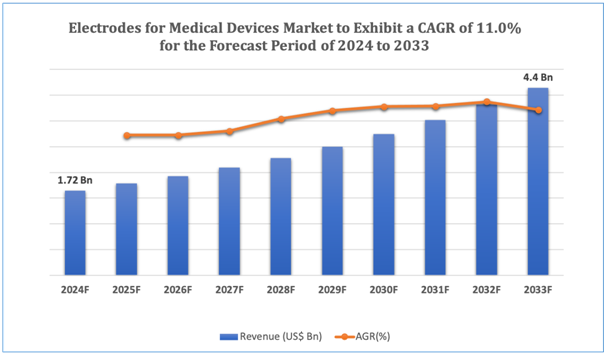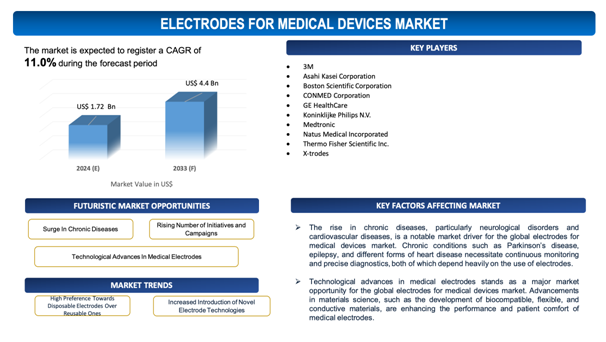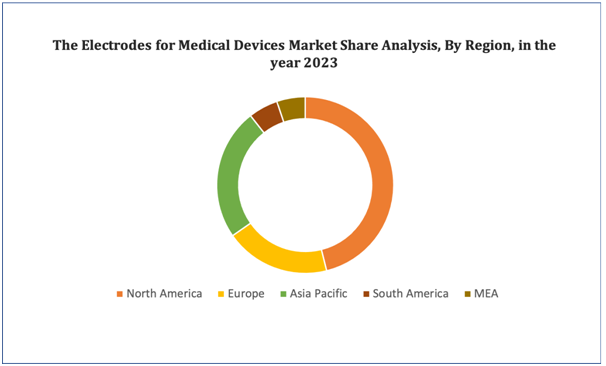Electrodes For Medical DevicesMarket Overview
The global electrodes for medical devices market is estimated to be worth over USD 4.4Bn in 2033 and is expected to grow at CAGR of11.0% during the forecast period (2024-2033).
Electrodes for medical devices are transforming the pharmaceutical and healthcare landscape by allowing precise monitoring, diagnosis, and treatment of various medical conditions. These electrodes are crucialelements in a scale of medical devices, including electrocardiograms (ECGs), electroencephalograms (EEGs), and neurostimulators. They function by detecting electrical signals from the body or delivering electrical stimulation to tissues, offering invaluable data and therapeutic effects that improve patient care.
In diagnostics, electrodes are critical in monitoring electrical activity in the heart, brain, and muscles. For instance, ECG electrodes capture the heart's electrical signals, assisting in the diagnosis of cardiac conditions such as arrhythmias and heart attacks. In a similar manner, EEG electrodes monitor brain activity, critical for diagnosing neurological disorders like epilepsy and sleep disorders. The increased precision and reliability of these electrodes ensure accurate data collection, resultinginimproved diagnostic outcomes and more personalized treatment plans.
Therapeutically, electrodes are used in advanced medical devices such as pacemakers, defibrillators, and deep brain stimulators. These devices deliver controlled electrical pulses to specific body parts, managing conditions like cardiac arrhythmias, chronic pain, and Parkinson's disease. The ability of electrodes to provide targeted therapy reduces side effects and improves treatment efficacy, significantly enhancing patient quality of life.
Technological advancements are further revolutionizing the outlook. Advancements in materials science have paved its way to the development of biocompatible and flexible electrodes that enhance patient comfort and device performance. Integration with wireless technologies allows remote monitoring and telemedicine applications, enabling continuous patient care and real-time health data analysis.
Moreover, the surge of wearable medical devices, commanded by advanced electrodes, is accelerating the move towards preventive healthcare. These wearables monitor vital signs and health metrics, offering early warnings of potential health issues and stimulating proactive health management.
In summary, electrodes for medical devices are revolutionizing the pharmaceutical and healthcare landscape by enabling precise diagnostics, effective therapies, and continuous health monitoring. Their advancements are leading to improved patient outcomes, personalized treatments, and a transition towards more preventive and proactive healthcare.
Figure 1. Electrodes For Medical Devices: Market Size

Get more details on this report - Request Free Sample
Key Market Insights
The global electrodes for medical devices market is witnessingrobust growth, fuelled by growing demand for advanced diagnostic and therapeutic tools in healthcare. Latest market insights reveal a growing adoption of wearable and implantable medical devices, such as EEG systems, ECG monitors, and neurostimulators, which rely on high-precision electrodes to function effectively. The aging population and prevalence of chronic diseases like neurological and cardiovascular disorders are significant factors accelerating market expansion.
Significant developments in the market comprisedevelopments in materials science, resultingin the creation of biocompatible, flexible, and miniaturized electrodes. These advancementsimprove patient comfort and device performance, making long-term monitoring and implantable applications more feasible. For example, the utility of conductive polymers and nanomaterials has enhanced electrode conductivity and durability, ensuring reliable performance in different physiological conditions.
Novel technologies are also defining the market outlook. The combination of wireless communication and internet of things (IoT) capabilities in electrode-based devices enables for remote monitoring and real-time data analysis. This is especiallyrevolutionary for administering chronic diseases and post-surgical care, as patients can be monitored continuously without frequent hospital visits. In addition, the development of dry electrodes that do not require conductive gels is simplifying the use and maintenance of diagnostic devices, further accelerating their adoption.
The soaring emphasis on personalized medicine and preventive healthcare is fuelling the demand for wearable health monitors equipped with advanced electrodes. These devices offer continuous tracking of vital signs, allowing early detection of health issues and more customized healthcare interventions.
Therefore, the global electrodes for medical devices market is characterized by technological advancements and increasing adoption of innovative, patient-friendly solutions. Significant developments in materials and wireless technologies are enhancing the functionality and application of electrodes, boosting market growth and transforming healthcare delivery.
Market Dynamics
Market Drivers
Surge In Chronic Diseases, Particularly Neurological Disorders and Heart Diseases
The rise in chronic diseases, particularly neurological disorders and cardiovascular diseases, is a notable market driver for the global electrodes for medical devices market. Chronic conditions such as Parkinson’s disease, epilepsy, and different forms of heart disease necessitate continuous monitoring and precise diagnostics, both of which depend heavily on the use of electrodes. For instance, electrocardiogram (ECG) electrodes are crucial for monitoring heart health, identifying arrhythmias, and managing patients with heart disease. In a similar manner, electroencephalogram (EEG) electrodes are crucial in diagnosing and monitoring neurological disorders, offeringcrucial data on brain activity that informs treatment plans.
The increasing prevalence of these chronic diseases is driving the demand for advanced medical devices that can offer accurate, real-time monitoring and effective management of patient health. This demand is further intensified by the aging global population, which is more susceptible to such chronic conditions, thus expanding the market for medical devices equipped with electrodes.
In addition, the management of chronic diseases often needs long-term monitoring and frequent adjustments to treatment regimens, which are supported by the continuous data provided by electrode-based devices. This continuous data stream is invaluable for personalized medicine, enabling healthcare providers to personalize treatments to individual patient needs, thusenhancing outcomes and quality of life.
Technological developments in electrode design, such as the development of flexible, biocompatible, and wireless electrodes, are improving the functionality and patient comfort of these devices, making them more suitable for long-term use. This is encouraging more widespread adoption of electrode-based monitoring and therapeutic devices in managing chronic diseases.
Overall, the growing incidence of chronic neurological and heart diseases is a significant driver for the electrodes for medical devices market, as it accelerates the need for reliable, advanced, and patient-friendly diagnostic and monitoring solutions.
Market Restraints
With regard to numerous advantages of electrodes for medical devices, the market faces several challenges due to the unique characteristics and requirements associated with these potent pharmaceutical products. Some of the key market challenges include:
- High Cost of Advanced Electrode Technologies: The development and production of advanced electrodes, such as those made from biocompatible and flexible materials or incorporate with wireless capabilities, can be expensive. These increased costs can be a challenge to adoption, especially in resource-constrained settings or for smaller healthcare providers. In addition, the expense related to the initial purchase, maintenance, and replacement of sophisticated electrode-based devices can limit their widespread use, especially in emerging markets where healthcare budgets may be more restrictive.
- Stringent Regulatory Requirements and Approval Processes: Medical devices incorporating electrodes must meet rigorous regulatory standards to ensure their efficacy, safety, and quality. Navigating these complex regulatory environments can be time-consuming and costly, potentially delaying the introduction of new products to the market. Various countries have changing regulatory requirements, adding further intricacy for companies operating on a worldwide scale. These stringent requirements can hamper innovation and slow down the commercialization of novel technologies, affecting the growth of the electrodes for medical devices market.

Get more details on this report - Request Free Sample
Market Opportunity
Technological Advances In Medical Electrodes
Technological advances in medical electrodes stands as a major market opportunity for the global electrodes for medical devices market. Advancements in materials science, such as the development of biocompatible, flexible, and conductive materials, are enhancing the performance and patient comfort of medical electrodes. These advancements enable the creation of electrodes that can conform to the body's contours, minimize skin irritation, and offer more reliable and accurate signal detection. As a conseuqence, they are specifically beneficial for long-term monitoring and wearable medical devices, which are gaining momentum in the management of chronic diseases and remote patient monitoring.
In addition, the incorporation of smart technologies, such as wireless communication and Internet of Things (IoT) capabilities, is revolutionizingconventional medical electrodes into sophisticated diagnostic and therapeutic tools. Wireless electrodes enable for continuous, real-time monitoring of patients' vital signs without the need for restrictive cables, improving patient mobility and comfort. This is especially advantageous in settings like home healthcare and telemedicine, where continuous monitoring can resultinimproved disease management and early intervention.
Advanced manufacturing techniques, comprising 3D printing and nanotechnology, are also fuelling innovation in electrode design and production. These methodsallowthe creation of highly tailored and miniaturized electrodes that can be customized to specific medical applications, improving their effectiveness and expanding their scale of use.
Overall, technological developments in medical electrodes are charting new courses for innovation and application in the global medical devices market. These advancements are accelerating the development of more efficient, comfortable, and versatile electrodes, which are critical for modern diagnostic and therapeutic practices, ultimately improving patient outcomes and expanding market growth.
Bottom of Form
Market Trends
- High Preference Towards Disposable Electrodes Over Reusable Ones: There is a growing trend towards the use of disposable electrodes rather than reusable ones in medical devices. This shift is driven by the increasing emphasis on infection control and the need to reduce cross-contamination risks, especially in critical care settings and during the COVID-19 pandemic. Disposable electrodes offer a safer and more hygienic option, as they are single-use and do not require the extensive cleaning and sterilization procedures that reusable electrodes do. This preference is also supported by advancements in manufacturing that have made disposable electrodes more cost-effective without compromising on performance and reliability. Healthcare facilities are adopting disposable electrodes to ensure patient safety and streamline operational efficiency, further fuelling this trend.
- Increased Introduction of Novel Electrode Technologies: The medical electrodes market is witnessing a surge in the introduction of novel technologies aimed at enhancing diagnostic accuracy, patient comfort, and overall device performance. Innovations such as dry electrodes, which eliminate the need for conductive gels, are gaining traction due to their ease of use and maintenance. Additionally, advancements in flexible and stretchable electrodes made from materials like graphene and conductive polymers are enabling better conformity to the body's contours, improving signal quality and patient comfort. These novel technologies are expanding the application range of medical electrodes, from wearable health monitors to advanced neurostimulation devices, driving market growth and setting new standards for medical diagnostics and treatments.
Electrodes For Medical Devices Market: Key Segments
By Type
- Diagnostics
- Electrocardiogram (ECG)
- Electroencephalogram (EEG)
- Electromyogram (EMG)
- Electroretinogram (ERG)
- Fetal Scalp
- Other
- Therapeutics
- Pacemaker
- Transcutaneous Electrical Nerve Stimulator (TENS)
- Defibrillator
- Electrosurgical
- Other
By Key Geographical Regions
- North America
- Europe
- Asia-Pacific
- Middle East and Africa
- South America
Figure 4. Electrodes For Medical Devices Market: Distribution by Region

Get more details on this report - Request Free Sample
Electrodes For Medical Devices Market: Regional Analysis
North America and Europe are the largest contributors to the electrodes for medical devices market, owing to the growing focus on regular technological advancements in the electrodes, the rising older age population, high expenditure in the healthcare sector, and the presence of key players in the region.
Leading Electrodes For Medical Devices Developers
Industry Trends and Global Forecasts, 2023-2035 report features an extensive study of the current market landscape, market size and future opportunities associated with the electrodes for medical devices market, during the given forecast period. Further, the market report highlights the efforts of several stakeholders engaged in this rapidly emerging segment of the biopharmaceutical industry. Key takeaways of the Electrodes For Medical Devicesmarket are briefly discussed below.
The report includes the list of players operating in the global electrodes for medical devices market. Some of the key players include:
- 3M
- Asahi Kasei Corporation
- Boston Scientific Corporation
- CONMED Corporation
- GE HealthCare
- Koninklijke Philips N.V.
- Medtronic
- Natus Medical Incorporated
- Thermo Fisher Scientific Inc.
- X-trodes
Electrodes For Medical Devices Market: Key Developments
- In May 2024, Soterix Medical has announced the launch of the MxN-GO EEG system that integrates high-definition transcranial electrical stimulation (HD-tES) with EEG capabilities.This system is designed to facilitate research applications that require both electrical brain stimulation and activity recording in mobile and natural settings.
Scope of the Report
The market report presents an in-depth analysis of the various firms / organizations that are engaged in this market, across different segments, as defined in the below table:
|
|
Key Report Attributes |
Details |
||
|
|
Base Year |
2023 |
||
|
|
Forecast Period |
2024-2033 |
||
|
|
CAGR (2024-2033) |
11.0% |
||
|
|
Type |
|
||
|
|
Key Geographical Regions |
|
||
|
Key Companies Profiled |
|
|
||
